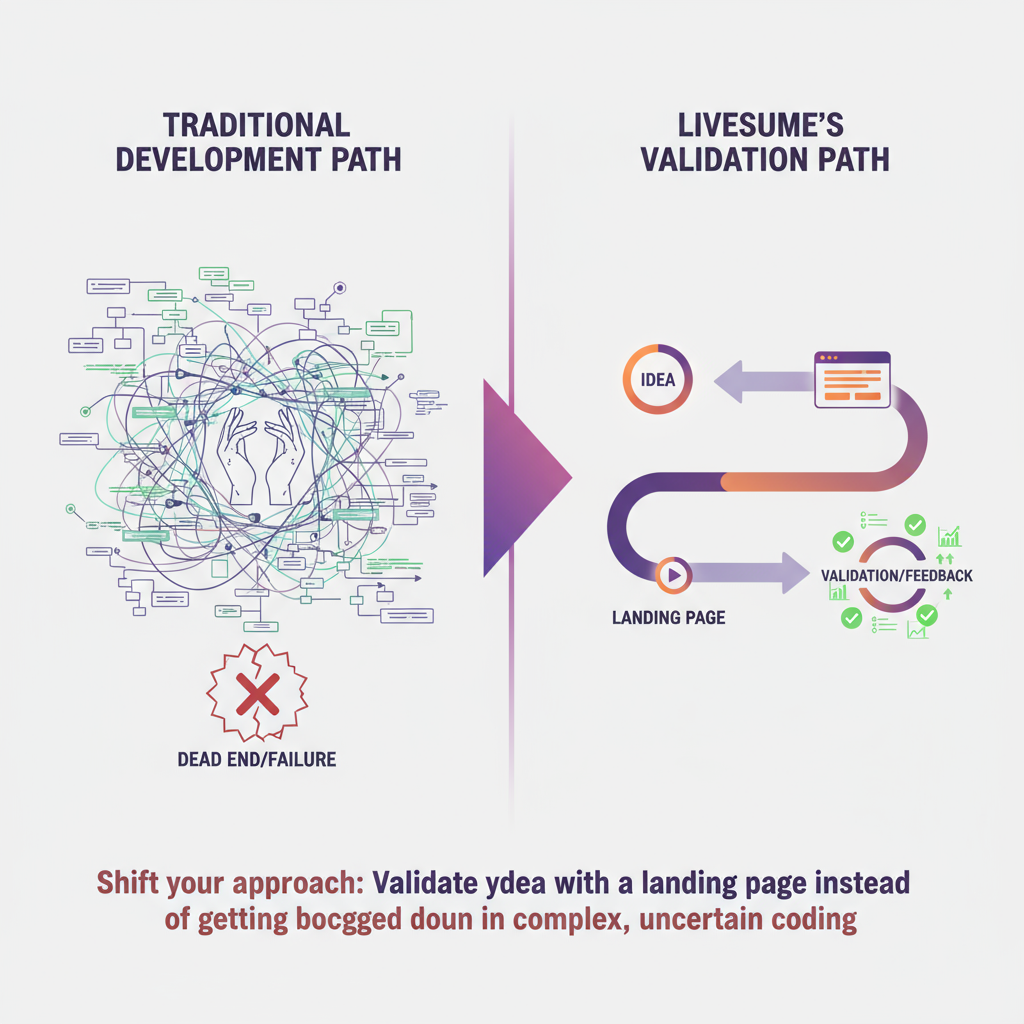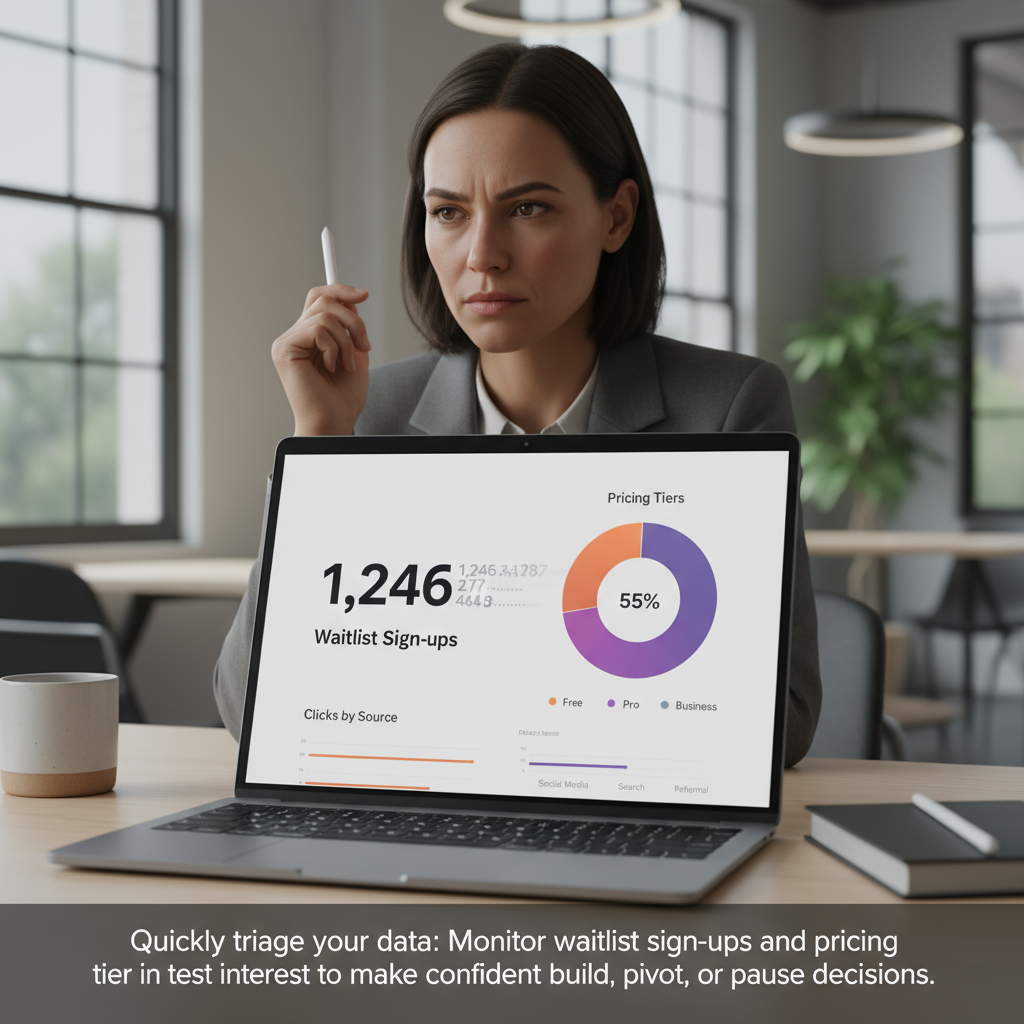You’ve got a brilliant idea for a micro-SaaS product. You can already picture the dashboard and the delighted users. But then the dread kicks in: months of coding, thousands of dollars burned, and the nagging fear that you might be building something nobody will actually pay for. What if you could skip the build and go straight to the sell? That's not just a fantasy—it's a strategy, and you can execute it this weekend.
Key Takeaways
- Validate, Don't Build: Discover how a simple landing page can act as a powerful no-code MVP to test your SaaS idea’s market demand before you invest significant time and money.
- The 48-Hour Framework: Get a step-by-step plan to go from a raw idea to collecting real user feedback and purchase intent in a single weekend.
- AI as Your Co-founder: See how AI tools, like those built into the Livesume landing page builder, can write your sales copy, define your value proposition, and accelerate the entire process.
- Data Over Drama: Learn what metrics actually matter (hint: it's not just traffic) and how to use them to make a confident decision to build, pivot, or pause.
What If Your MVP Wasn't a Product, But a Sales Page?
The traditional Minimum Viable Product (MVP) has a fatal flaw for solo founders: it still requires a *product*. This assumption drags you into weeks or months of development. The lean alternative is the "sales-first" MVP. It’s a simple, high-quality landing page designed to do one thing: validate that people want your solution enough to give you their email or even their credit card details.
It’s a fundamental shift from asking "Can I build this?" to proving "Should I build this?"
- Before: A founder spends 3 months and $5,000 building a clunky version 1.0, only to launch to crickets. The idea was a dud, and the investment is gone.
- After: A founder spends an afternoon and less than $50 on a live resume or page. They drive some traffic and learn within 48 hours that nobody is clicking the "Pro" pricing tier. They just saved themselves 3 months of wasted effort.
This isn't about faking it. It’s about being strategic. You’re not selling a product that doesn’t exist; you’re selling a vision and measuring the response.

The 48-Hour Validation Framework: From Idea to First Signal
Ready to stress-test your idea? Don't overthink it. Just follow the timeline. Here’s how you can launch your no-code MVP this weekend.
Day 1: Strategy & Build (The First 24 Hours)
Today is all about getting your validation engine built and ready to launch.
Step 1: Pinpoint Your Core Promise (The 15-Minute Value Prop)
You don't need a perfect marketing plan. You need one killer sentence. What is the single biggest pain point you solve for a specific person? Use AI to rapidly cycle through options. Prompt it with something like: "Generate 10 value propositions for a tool that helps freelance writers track their project profitability." Tweak your favorite one. Done.
Step 2: Build Your Instant MVP with Livesume
This is where speed is your secret weapon. Instead of wrestling with a complex tool like Webflow, you can use an AI-powered tool like the Livesume website builder to generate a professional-looking page in minutes. Focus on these key elements:
- A Clear Headline: Your core promise from Step 1.
- A Compelling Sub-headline: Briefly explain who it's for and what it does.
- A Simple "How It Works": Use 3-4 bullet points or icons to explain the process.
- A Single Call-to-Action (CTA): "Join the Waitlist" or "Get Early Access."
Step 3: Implement the "Pricing Tier Test"
This is the most crucial part. Add a simple pricing section with two or three tiers (e.g., Free, Pro, Business). Don't link them to a payment processor yet. Just make the buttons clickable and point them to your waitlist form. This non-committal test tells you what features people value most. Are they clicking on the cheap plan or the one with all the best features? That’s gold. This is a core part of validating your idea, a concept we explore more in our article on AI-driven idea validation.
Ready to Build Your Validation Engine?
Stop coding in the dark. Use Livesume to turn your Micro-SaaS idea into a validated, lead-generating asset in less than 48 hours. Create your page in the next 15 minutes and have it ready by tonight.
Start Building for Free
Day 2: Launch & Learn (The Next 24 Hours)
With your page live, it's time to get some eyeballs on it and see what happens.
Step 4: Drive Initial, Targeted Traffic
You don’t need a massive ad budget. You need feedback from the right people. Go where your target users hang out:
- Post in a relevant subreddit or Facebook group (read the rules first!). Frame it as "seeking feedback on an idea," not "buy my stuff."
- Share it on your personal LinkedIn or Twitter and ask your network for honest thoughts.
- Directly message 10-20 people you think are a perfect fit for the product.
The goal isn't 10,000 visitors. It's 50-100 highly relevant visitors.
Step 5: Triage the Data
After a day, look at the signals. How many people signed up for the waitlist? Which pricing tier did they click on most? Did anyone reply to your posts with questions or objections? Every piece of data is a clue. This process is about building a client-winning engine, not just a gallery of ideas.

So, Is The Idea a Go? Interpreting Your Results
The 48 hours are up. Now what? You’re not looking for a vague "people liked it." You’re looking for a clear signal.
- Strong Positive Signal (Build!): You got a 5-10% conversion rate on your waitlist sign-up, and people were clicking your "Pro" tier. You received direct messages asking when it will be ready. It's time to start planning the actual build.
- Lukewarm Signal (Pivot): A few people signed up, but they all clicked the "Free" plan. The feedback was "it's a neat idea, but..." This tells you the pain point isn't strong enough, or your solution is misaligned. Can you tweak the angle and re-test?
- Negative Signal (Pause): Zero sign-ups. No engagement. Crickets. This is not a failure—it's a massive success! You just saved yourself months of work on an idea with no market. Dust yourself off and move on to the next one.
Frequently Asked Questions
Can a landing page really be an MVP?
For validation, absolutely. A "sales-first" MVP tests the most critical part of your business: purchase intent. If you can't get someone to give you their email for a solution, you'll have a much harder time getting them to pay for it.
How do you test a SaaS idea without any code?
By using the framework in this article. Build a landing page that clearly explains the value proposition, add a pricing test to gauge interest, and drive a small amount of targeted traffic to it. The sign-ups and clicks are your data.
How much should a no-code MVP cost?
Dramatically less than a coded one. Using a tool like Livesume, your primary cost is the subscription, which can be less than $50. The goal is to keep validation costs as close to zero as possible.
What are the best no-code tools for this kind of MVP?
For a pure validation landing page, a fast, AI-integrated builder like Livesume is ideal. For building a more functional, interactive no-code product *after* validation, tools like Bubble or Softr are excellent choices, though they have a much steeper learning curve.
What metrics should I track for MVP validation?
Focus on three things: the conversion rate from visitor to waitlist sign-up, the distribution of clicks across your pricing tiers, and the qualitative feedback you get from direct outreach and community posts.
Turn Your Test Into a Real Asset
That landing page you built isn’t a throwaway experiment. If your idea gets a green light, that page becomes your pre-launch headquarters. It’s the start of your email list and your first marketing asset. You haven't just tested an idea; you’ve built the foundation of your customer pipeline.
Stop guessing and start validating. Your next great idea doesn’t need a 6-month development cycle. It needs a weekend.
Here are your action steps:
- Commit to the 48-hour sprint. Block off time this weekend.
- Build your no-code MVP using the framework and a tool like the Livesume landing page builder.
- Share it with at least 50 relevant people.
- Analyze the data and make a confident decision.